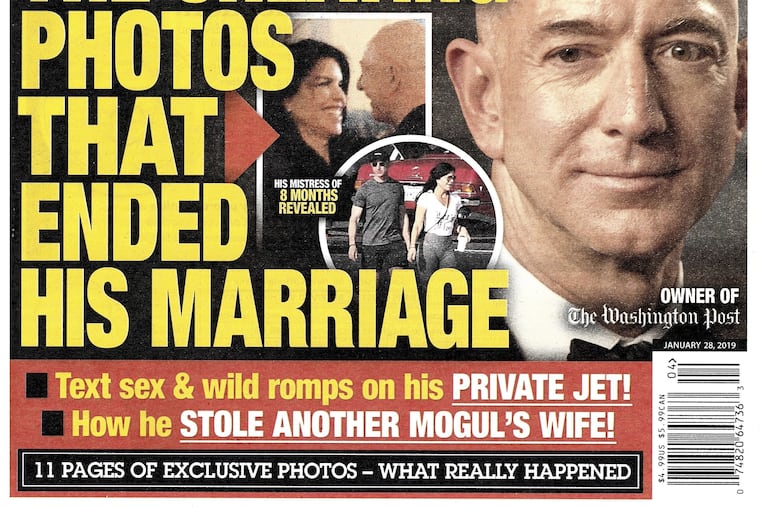Sensationalism has been the National Enquirer’s lifeblood since its early days
Since its birth in New York, the Enquirer has operated on the fringes of traditional journalism.

The National Enquirer, no relation to the Philadelphia Inquirer, has been in the news itself lately, from its admitted role in covering up alleged sexual indiscretions by Donald Trump before he was elected president to a charge by Jeff Bezos, the richest man in the world, that the news outlet has been trying to blackmail him.
A newspaper known for breaking stories that have damaged reputations — remember John Edwards, the North Carolina senator whose presidential aspirations were dashed by disclosure of a love child in 2008 — the Enquirer has often played on the rule-breaking fringe of traditional journalism.
When it was founded in 1926, it started as something unimaginable today: an afternoon Sunday newspaper.
It was known as the New York Evening Enquirer in its early years. Its publisher, William Griffin, a former adman, received funding and guidance from William Randolph Hearst, who with newspaper competitor Joseph Pulitzer — he of the prestigious news-industry prize — was a founding father of “yellow journalism,” the precursor to what is now called tabloid journalism.
“At Hearst’s behest the Enquirer experimented with journalistic methods and standards, such as embellishing stories to attract more reader attention; Hearst would then adopt the more successful techniques for his own papers,” according to the Encyclopedia Britannica.
The paper struggled for years, particularly during World War II, after Griffin adopted an isolationist position.
Generoso Pope Jr., whose father founded the Italian-language New York daily newspaper Il Progresso Italo-Americano, bought the Enquirer in 1952 for $75,000, reportedly with the help of legendary mobster Frank Costello, a family friend.
The next year, the Massachusetts Institute of Technology-educated publisher turned it into a tabloid and focused coverage on crime and gore, using big headlines and bloody photos from murder and car crash scenes.
As circulation started to build, he renamed the paper the National Enquirer in 1957 and started marketing it nationwide.
In the 1960s, with his readership moving to the suburbs, Pope struck a deal with major supermarket chains to build racks that would put magazines at eye level at checkouts. With that move, which proved profitable to all parties, supermarket tabloids were born.
“It gave us complete exposure, saturation, whatever you want to call it,” his son Paul David Pope told the New York Times in December.
In the late 1960s and 1970s, the paper shifted to coverage dominated by celebrity gossip and the foibles of politicians, such as Edwards and Gary Hart, whose own presidential ambitions were finally sunk after the Enquirer, following stories by the Miami Herald, found and published a photo of the politician with his mistress on his lap on a boat named Monkey Business.
After Pope’s death in 1988, GP Group Acquisitions bought his operations, which included the Enquirer and a sister tab, Weekly World News, which published headline-grabbing made-up stories that included alien abductions, prophecies of future catastrophes, and the saga of a semi-human child called Bat Boy.
GP Group Acquisitions changed its name in 1996 to American Media Inc., and its titles now include US Weekly, Men’s Journal, and Life & Style.
AMI chairman and CEO David Pecker is a longtime friend of Trump. In 2016, the National Enquirer ran numerous front-page stories promoting the candidacy of the New York developer and reality TV show host and bashing his Democratic opponent, Hillary Clinton. The attacks on Clinton included headlines that falsely reported she had brain cancer and was dying.
After Trump’s election, the paper repeatedly came to his defense in the ongoing Russia investigation, claiming Trump had been framed by former President Barack Obama and Clinton with the help of “corrupt FBI cronies.”
In December, AMI admitted it coordinated with Trump’s presidential campaign to pay $150,000 in hush money to a Playboy model who claimed she had had an affair with Trump.
Now the Enquirer and its owners are facing a challenge from one of Trump’s favorite targets, Bezos, who besides owning Amazon also owns the Washington Post.
The Enquirer recently published a number of stories on the breakup of Bezos’ marriage and his relationship with Lauren Sanchez, a former TV anchor who is also married.
On Thursday, Bezos said he was the target of “extortion and blackmail” by the publication, which he said threatened to publish revealing personal photos of him unless he stopped investigating how the tabloid obtained his private exchanges with Sanchez.
Where it goes from here it is not clear, but as with so many stories involving the Enquirer, expect some mudslinging.
And some of that mud landed on the Jesuit magazine America, where the editor, the Rev. Matt Malone, tweeted a request that his organization, America Media, not be confused with American Media Inc., the Enquirer’s owner.
We at the Inquirer know all about that.